GSBS6012 Entrepreneurship and Innovation: Samsung's Plan
VerifiedAdded on 2023/06/09
|15
|4359
|282
Project
AI Summary
This project provides a comprehensive analysis of Samsung's innovation plan, focusing on the development and commercialization of a new smartphone featuring a full-body glass design, face unlock, and an in-display fingerprint sensor. The assignment utilizes the Innovation Diamond model to assess Samsung's technological readiness and the RENT model to evaluate the product's market potential and risk. It details the new product development process, market considerations, and steps taken to develop the technological innovation. The analysis includes the preparation of the firm for technological innovation, a return-risk analysis, and a discussion of the impact of the new project on the firm's success over the next 5 to 10 years, concluding with a thorough evaluation of the project's potential. The document also includes an executive summary, table of contents, and references to support the analysis. The assignment also analyzes the firm's market consideration and strategic planning to maintain its position in the market and create new market space.
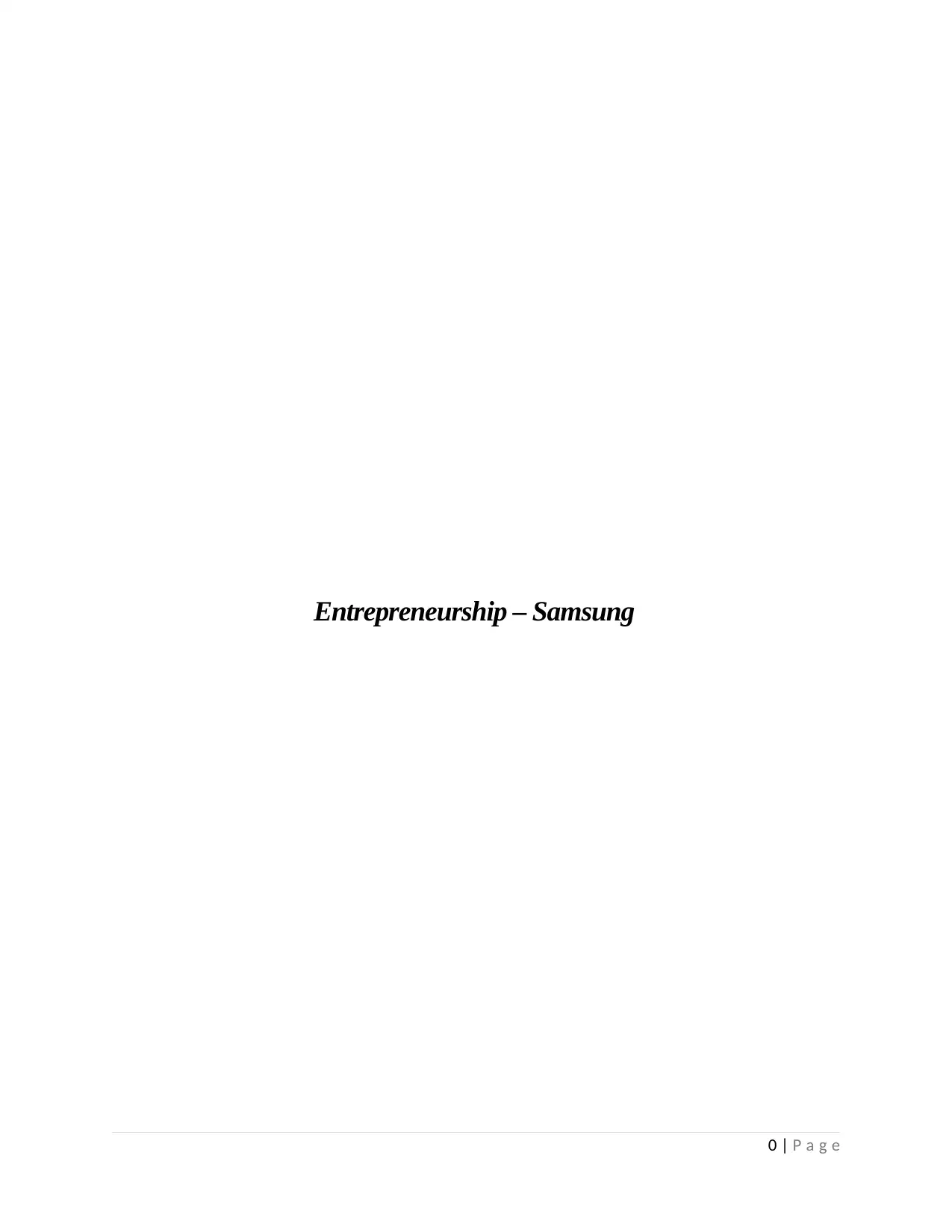
Entrepreneurship – Samsung
0 | P a g e
0 | P a g e
Paraphrase This Document
Need a fresh take? Get an instant paraphrase of this document with our AI Paraphraser
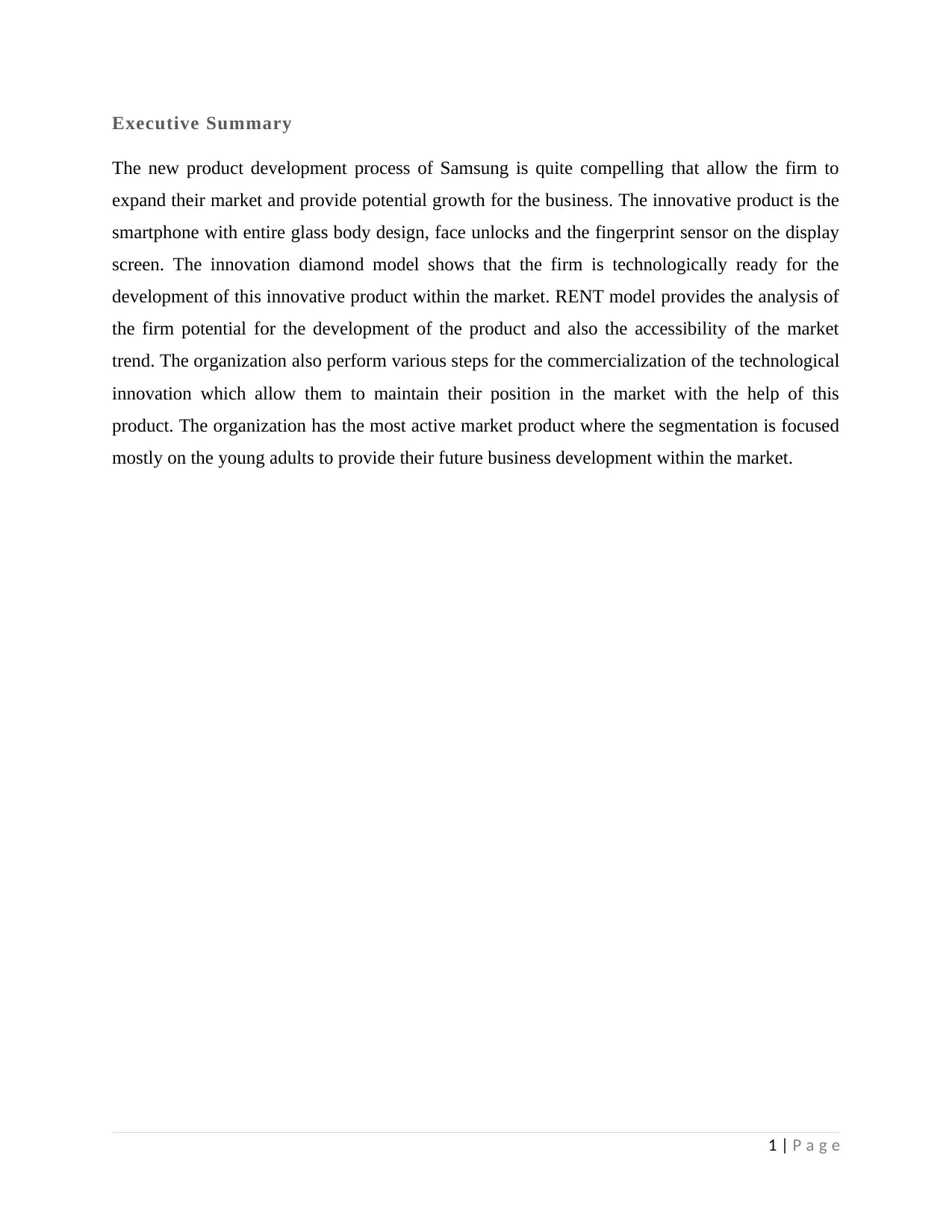
Executive Summary
The new product development process of Samsung is quite compelling that allow the firm to
expand their market and provide potential growth for the business. The innovative product is the
smartphone with entire glass body design, face unlocks and the fingerprint sensor on the display
screen. The innovation diamond model shows that the firm is technologically ready for the
development of this innovative product within the market. RENT model provides the analysis of
the firm potential for the development of the product and also the accessibility of the market
trend. The organization also perform various steps for the commercialization of the technological
innovation which allow them to maintain their position in the market with the help of this
product. The organization has the most active market product where the segmentation is focused
mostly on the young adults to provide their future business development within the market.
1 | P a g e
The new product development process of Samsung is quite compelling that allow the firm to
expand their market and provide potential growth for the business. The innovative product is the
smartphone with entire glass body design, face unlocks and the fingerprint sensor on the display
screen. The innovation diamond model shows that the firm is technologically ready for the
development of this innovative product within the market. RENT model provides the analysis of
the firm potential for the development of the product and also the accessibility of the market
trend. The organization also perform various steps for the commercialization of the technological
innovation which allow them to maintain their position in the market with the help of this
product. The organization has the most active market product where the segmentation is focused
mostly on the young adults to provide their future business development within the market.
1 | P a g e
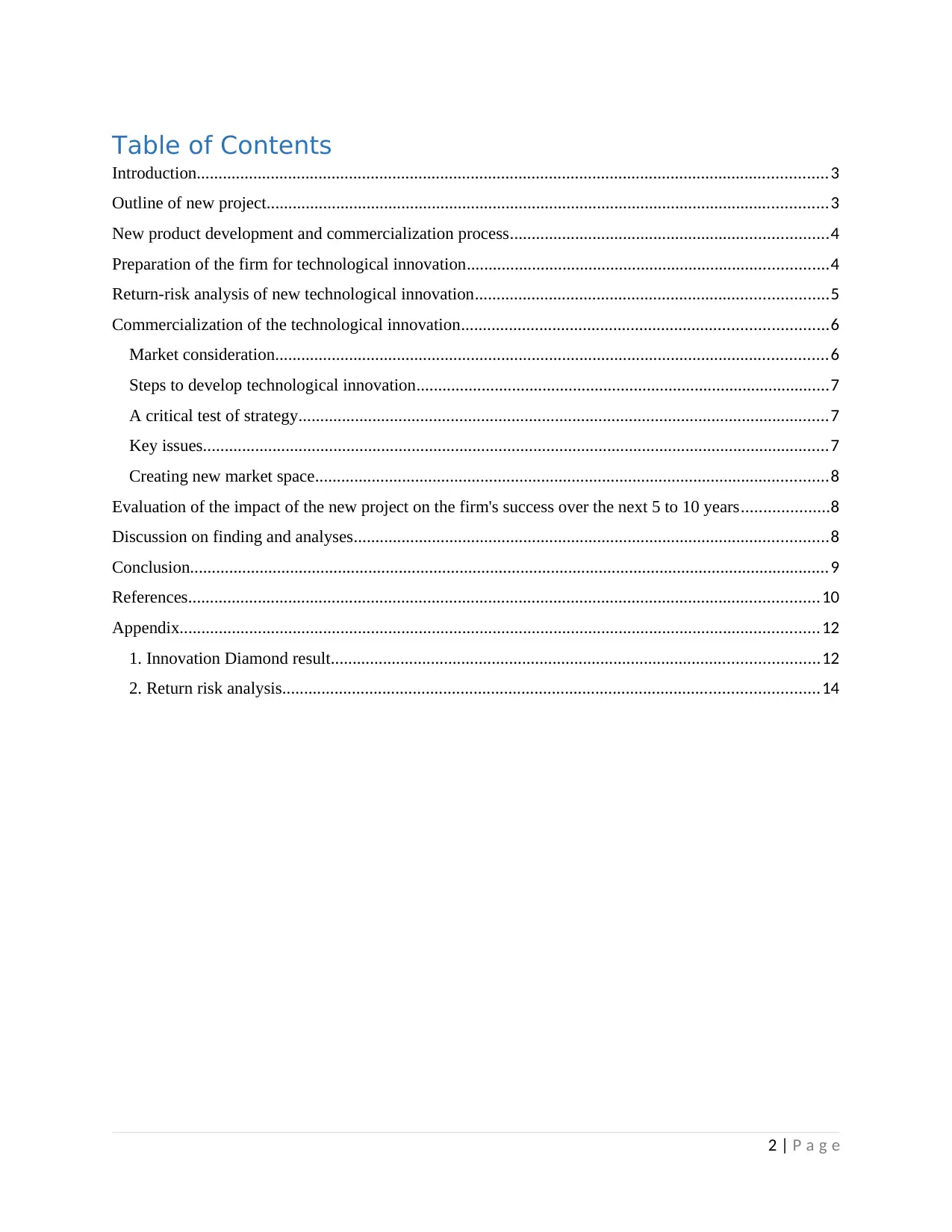
Table of Contents
Introduction.................................................................................................................................................3
Outline of new project.................................................................................................................................3
New product development and commercialization process.........................................................................4
Preparation of the firm for technological innovation...................................................................................4
Return-risk analysis of new technological innovation.................................................................................5
Commercialization of the technological innovation....................................................................................6
Market consideration...............................................................................................................................6
Steps to develop technological innovation...............................................................................................7
A critical test of strategy..........................................................................................................................7
Key issues................................................................................................................................................7
Creating new market space......................................................................................................................8
Evaluation of the impact of the new project on the firm's success over the next 5 to 10 years....................8
Discussion on finding and analyses.............................................................................................................8
Conclusion...................................................................................................................................................9
References.................................................................................................................................................10
Appendix...................................................................................................................................................12
1. Innovation Diamond result................................................................................................................12
2. Return risk analysis...........................................................................................................................14
2 | P a g e
Introduction.................................................................................................................................................3
Outline of new project.................................................................................................................................3
New product development and commercialization process.........................................................................4
Preparation of the firm for technological innovation...................................................................................4
Return-risk analysis of new technological innovation.................................................................................5
Commercialization of the technological innovation....................................................................................6
Market consideration...............................................................................................................................6
Steps to develop technological innovation...............................................................................................7
A critical test of strategy..........................................................................................................................7
Key issues................................................................................................................................................7
Creating new market space......................................................................................................................8
Evaluation of the impact of the new project on the firm's success over the next 5 to 10 years....................8
Discussion on finding and analyses.............................................................................................................8
Conclusion...................................................................................................................................................9
References.................................................................................................................................................10
Appendix...................................................................................................................................................12
1. Innovation Diamond result................................................................................................................12
2. Return risk analysis...........................................................................................................................14
2 | P a g e
⊘ This is a preview!⊘
Do you want full access?
Subscribe today to unlock all pages.

Trusted by 1+ million students worldwide
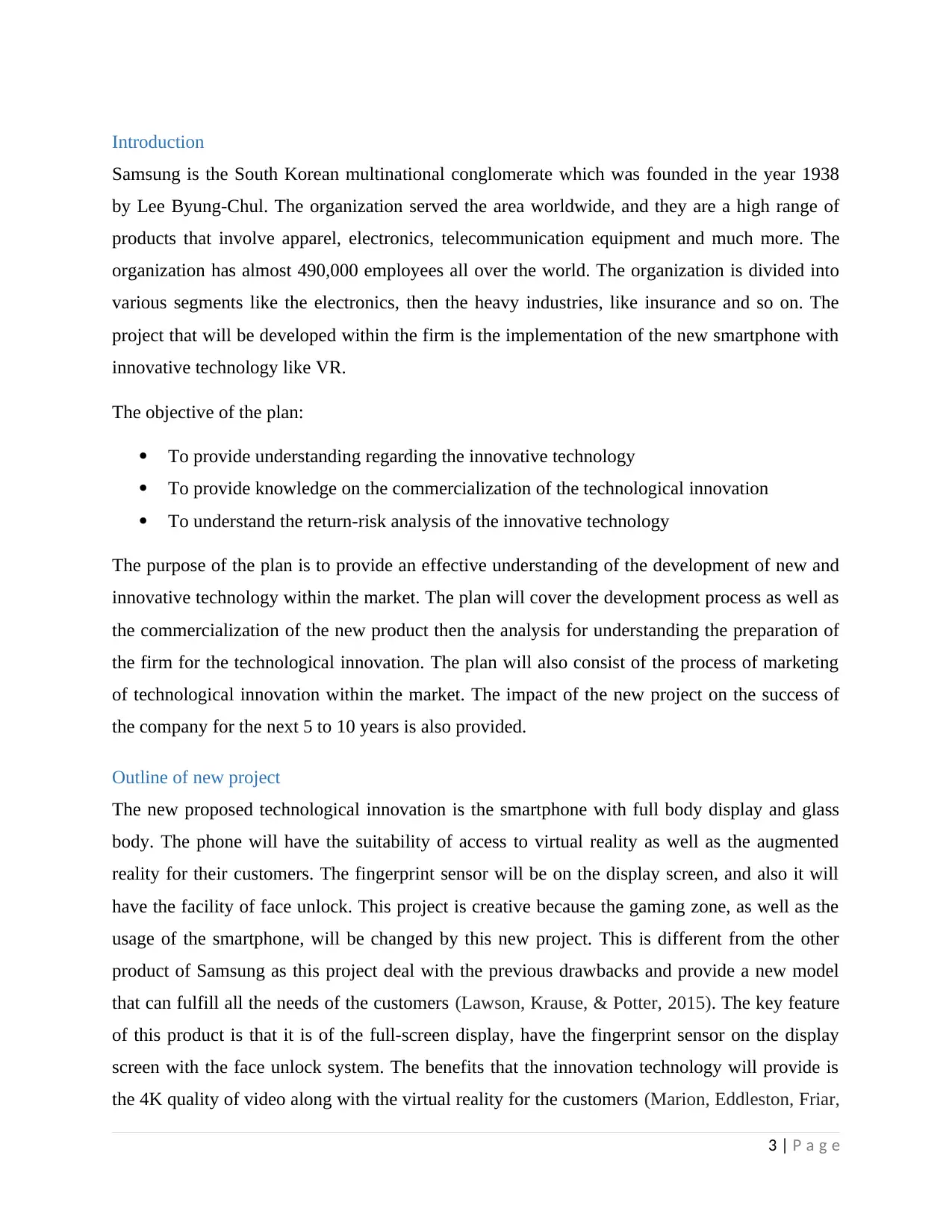
Introduction
Samsung is the South Korean multinational conglomerate which was founded in the year 1938
by Lee Byung-Chul. The organization served the area worldwide, and they are a high range of
products that involve apparel, electronics, telecommunication equipment and much more. The
organization has almost 490,000 employees all over the world. The organization is divided into
various segments like the electronics, then the heavy industries, like insurance and so on. The
project that will be developed within the firm is the implementation of the new smartphone with
innovative technology like VR.
The objective of the plan:
To provide understanding regarding the innovative technology
To provide knowledge on the commercialization of the technological innovation
To understand the return-risk analysis of the innovative technology
The purpose of the plan is to provide an effective understanding of the development of new and
innovative technology within the market. The plan will cover the development process as well as
the commercialization of the new product then the analysis for understanding the preparation of
the firm for the technological innovation. The plan will also consist of the process of marketing
of technological innovation within the market. The impact of the new project on the success of
the company for the next 5 to 10 years is also provided.
Outline of new project
The new proposed technological innovation is the smartphone with full body display and glass
body. The phone will have the suitability of access to virtual reality as well as the augmented
reality for their customers. The fingerprint sensor will be on the display screen, and also it will
have the facility of face unlock. This project is creative because the gaming zone, as well as the
usage of the smartphone, will be changed by this new project. This is different from the other
product of Samsung as this project deal with the previous drawbacks and provide a new model
that can fulfill all the needs of the customers (Lawson, Krause, & Potter, 2015). The key feature
of this product is that it is of the full-screen display, have the fingerprint sensor on the display
screen with the face unlock system. The benefits that the innovation technology will provide is
the 4K quality of video along with the virtual reality for the customers (Marion, Eddleston, Friar,
3 | P a g e
Samsung is the South Korean multinational conglomerate which was founded in the year 1938
by Lee Byung-Chul. The organization served the area worldwide, and they are a high range of
products that involve apparel, electronics, telecommunication equipment and much more. The
organization has almost 490,000 employees all over the world. The organization is divided into
various segments like the electronics, then the heavy industries, like insurance and so on. The
project that will be developed within the firm is the implementation of the new smartphone with
innovative technology like VR.
The objective of the plan:
To provide understanding regarding the innovative technology
To provide knowledge on the commercialization of the technological innovation
To understand the return-risk analysis of the innovative technology
The purpose of the plan is to provide an effective understanding of the development of new and
innovative technology within the market. The plan will cover the development process as well as
the commercialization of the new product then the analysis for understanding the preparation of
the firm for the technological innovation. The plan will also consist of the process of marketing
of technological innovation within the market. The impact of the new project on the success of
the company for the next 5 to 10 years is also provided.
Outline of new project
The new proposed technological innovation is the smartphone with full body display and glass
body. The phone will have the suitability of access to virtual reality as well as the augmented
reality for their customers. The fingerprint sensor will be on the display screen, and also it will
have the facility of face unlock. This project is creative because the gaming zone, as well as the
usage of the smartphone, will be changed by this new project. This is different from the other
product of Samsung as this project deal with the previous drawbacks and provide a new model
that can fulfill all the needs of the customers (Lawson, Krause, & Potter, 2015). The key feature
of this product is that it is of the full-screen display, have the fingerprint sensor on the display
screen with the face unlock system. The benefits that the innovation technology will provide is
the 4K quality of video along with the virtual reality for the customers (Marion, Eddleston, Friar,
3 | P a g e
Paraphrase This Document
Need a fresh take? Get an instant paraphrase of this document with our AI Paraphraser
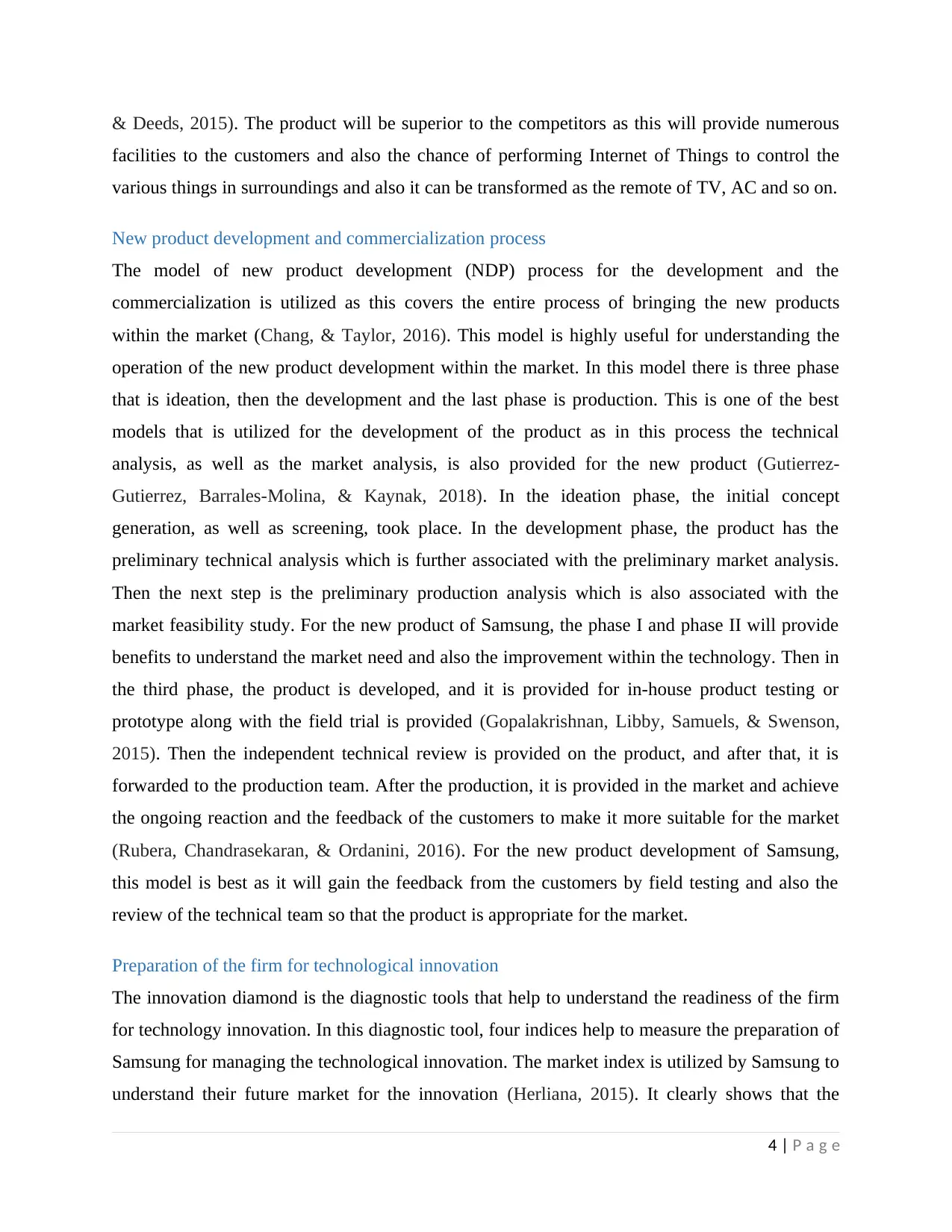
& Deeds, 2015). The product will be superior to the competitors as this will provide numerous
facilities to the customers and also the chance of performing Internet of Things to control the
various things in surroundings and also it can be transformed as the remote of TV, AC and so on.
New product development and commercialization process
The model of new product development (NDP) process for the development and the
commercialization is utilized as this covers the entire process of bringing the new products
within the market (Chang, & Taylor, 2016). This model is highly useful for understanding the
operation of the new product development within the market. In this model there is three phase
that is ideation, then the development and the last phase is production. This is one of the best
models that is utilized for the development of the product as in this process the technical
analysis, as well as the market analysis, is also provided for the new product (Gutierrez-
Gutierrez, Barrales-Molina, & Kaynak, 2018). In the ideation phase, the initial concept
generation, as well as screening, took place. In the development phase, the product has the
preliminary technical analysis which is further associated with the preliminary market analysis.
Then the next step is the preliminary production analysis which is also associated with the
market feasibility study. For the new product of Samsung, the phase I and phase II will provide
benefits to understand the market need and also the improvement within the technology. Then in
the third phase, the product is developed, and it is provided for in-house product testing or
prototype along with the field trial is provided (Gopalakrishnan, Libby, Samuels, & Swenson,
2015). Then the independent technical review is provided on the product, and after that, it is
forwarded to the production team. After the production, it is provided in the market and achieve
the ongoing reaction and the feedback of the customers to make it more suitable for the market
(Rubera, Chandrasekaran, & Ordanini, 2016). For the new product development of Samsung,
this model is best as it will gain the feedback from the customers by field testing and also the
review of the technical team so that the product is appropriate for the market.
Preparation of the firm for technological innovation
The innovation diamond is the diagnostic tools that help to understand the readiness of the firm
for technology innovation. In this diagnostic tool, four indices help to measure the preparation of
Samsung for managing the technological innovation. The market index is utilized by Samsung to
understand their future market for the innovation (Herliana, 2015). It clearly shows that the
4 | P a g e
facilities to the customers and also the chance of performing Internet of Things to control the
various things in surroundings and also it can be transformed as the remote of TV, AC and so on.
New product development and commercialization process
The model of new product development (NDP) process for the development and the
commercialization is utilized as this covers the entire process of bringing the new products
within the market (Chang, & Taylor, 2016). This model is highly useful for understanding the
operation of the new product development within the market. In this model there is three phase
that is ideation, then the development and the last phase is production. This is one of the best
models that is utilized for the development of the product as in this process the technical
analysis, as well as the market analysis, is also provided for the new product (Gutierrez-
Gutierrez, Barrales-Molina, & Kaynak, 2018). In the ideation phase, the initial concept
generation, as well as screening, took place. In the development phase, the product has the
preliminary technical analysis which is further associated with the preliminary market analysis.
Then the next step is the preliminary production analysis which is also associated with the
market feasibility study. For the new product of Samsung, the phase I and phase II will provide
benefits to understand the market need and also the improvement within the technology. Then in
the third phase, the product is developed, and it is provided for in-house product testing or
prototype along with the field trial is provided (Gopalakrishnan, Libby, Samuels, & Swenson,
2015). Then the independent technical review is provided on the product, and after that, it is
forwarded to the production team. After the production, it is provided in the market and achieve
the ongoing reaction and the feedback of the customers to make it more suitable for the market
(Rubera, Chandrasekaran, & Ordanini, 2016). For the new product development of Samsung,
this model is best as it will gain the feedback from the customers by field testing and also the
review of the technical team so that the product is appropriate for the market.
Preparation of the firm for technological innovation
The innovation diamond is the diagnostic tools that help to understand the readiness of the firm
for technology innovation. In this diagnostic tool, four indices help to measure the preparation of
Samsung for managing the technological innovation. The market index is utilized by Samsung to
understand their future market for the innovation (Herliana, 2015). It clearly shows that the
4 | P a g e
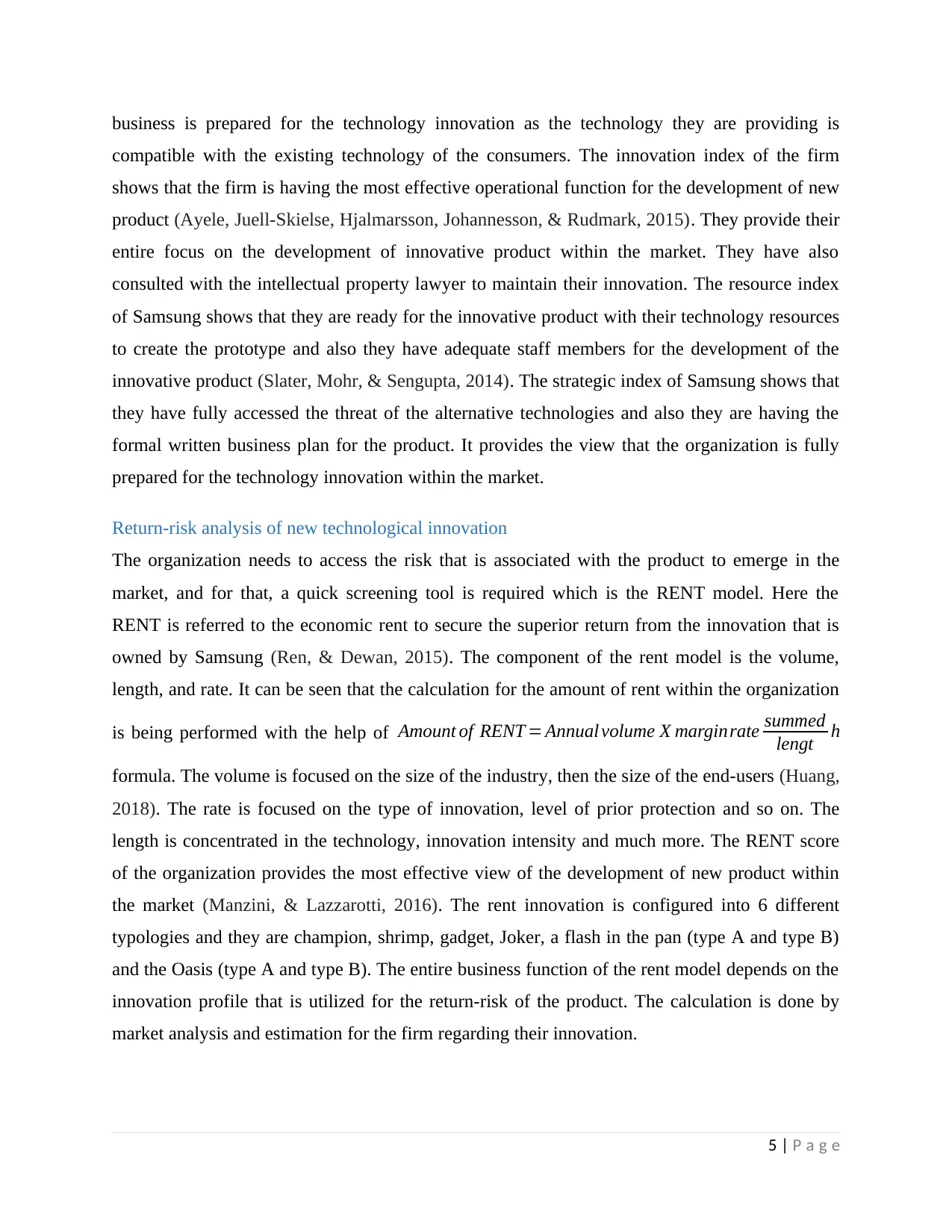
business is prepared for the technology innovation as the technology they are providing is
compatible with the existing technology of the consumers. The innovation index of the firm
shows that the firm is having the most effective operational function for the development of new
product (Ayele, Juell-Skielse, Hjalmarsson, Johannesson, & Rudmark, 2015). They provide their
entire focus on the development of innovative product within the market. They have also
consulted with the intellectual property lawyer to maintain their innovation. The resource index
of Samsung shows that they are ready for the innovative product with their technology resources
to create the prototype and also they have adequate staff members for the development of the
innovative product (Slater, Mohr, & Sengupta, 2014). The strategic index of Samsung shows that
they have fully accessed the threat of the alternative technologies and also they are having the
formal written business plan for the product. It provides the view that the organization is fully
prepared for the technology innovation within the market.
Return-risk analysis of new technological innovation
The organization needs to access the risk that is associated with the product to emerge in the
market, and for that, a quick screening tool is required which is the RENT model. Here the
RENT is referred to the economic rent to secure the superior return from the innovation that is
owned by Samsung (Ren, & Dewan, 2015). The component of the rent model is the volume,
length, and rate. It can be seen that the calculation for the amount of rent within the organization
is being performed with the help of Amount of RENT = Annual volume X marginrate summed
lengt h
formula. The volume is focused on the size of the industry, then the size of the end-users (Huang,
2018). The rate is focused on the type of innovation, level of prior protection and so on. The
length is concentrated in the technology, innovation intensity and much more. The RENT score
of the organization provides the most effective view of the development of new product within
the market (Manzini, & Lazzarotti, 2016). The rent innovation is configured into 6 different
typologies and they are champion, shrimp, gadget, Joker, a flash in the pan (type A and type B)
and the Oasis (type A and type B). The entire business function of the rent model depends on the
innovation profile that is utilized for the return-risk of the product. The calculation is done by
market analysis and estimation for the firm regarding their innovation.
5 | P a g e
compatible with the existing technology of the consumers. The innovation index of the firm
shows that the firm is having the most effective operational function for the development of new
product (Ayele, Juell-Skielse, Hjalmarsson, Johannesson, & Rudmark, 2015). They provide their
entire focus on the development of innovative product within the market. They have also
consulted with the intellectual property lawyer to maintain their innovation. The resource index
of Samsung shows that they are ready for the innovative product with their technology resources
to create the prototype and also they have adequate staff members for the development of the
innovative product (Slater, Mohr, & Sengupta, 2014). The strategic index of Samsung shows that
they have fully accessed the threat of the alternative technologies and also they are having the
formal written business plan for the product. It provides the view that the organization is fully
prepared for the technology innovation within the market.
Return-risk analysis of new technological innovation
The organization needs to access the risk that is associated with the product to emerge in the
market, and for that, a quick screening tool is required which is the RENT model. Here the
RENT is referred to the economic rent to secure the superior return from the innovation that is
owned by Samsung (Ren, & Dewan, 2015). The component of the rent model is the volume,
length, and rate. It can be seen that the calculation for the amount of rent within the organization
is being performed with the help of Amount of RENT = Annual volume X marginrate summed
lengt h
formula. The volume is focused on the size of the industry, then the size of the end-users (Huang,
2018). The rate is focused on the type of innovation, level of prior protection and so on. The
length is concentrated in the technology, innovation intensity and much more. The RENT score
of the organization provides the most effective view of the development of new product within
the market (Manzini, & Lazzarotti, 2016). The rent innovation is configured into 6 different
typologies and they are champion, shrimp, gadget, Joker, a flash in the pan (type A and type B)
and the Oasis (type A and type B). The entire business function of the rent model depends on the
innovation profile that is utilized for the return-risk of the product. The calculation is done by
market analysis and estimation for the firm regarding their innovation.
5 | P a g e
⊘ This is a preview!⊘
Do you want full access?
Subscribe today to unlock all pages.

Trusted by 1+ million students worldwide
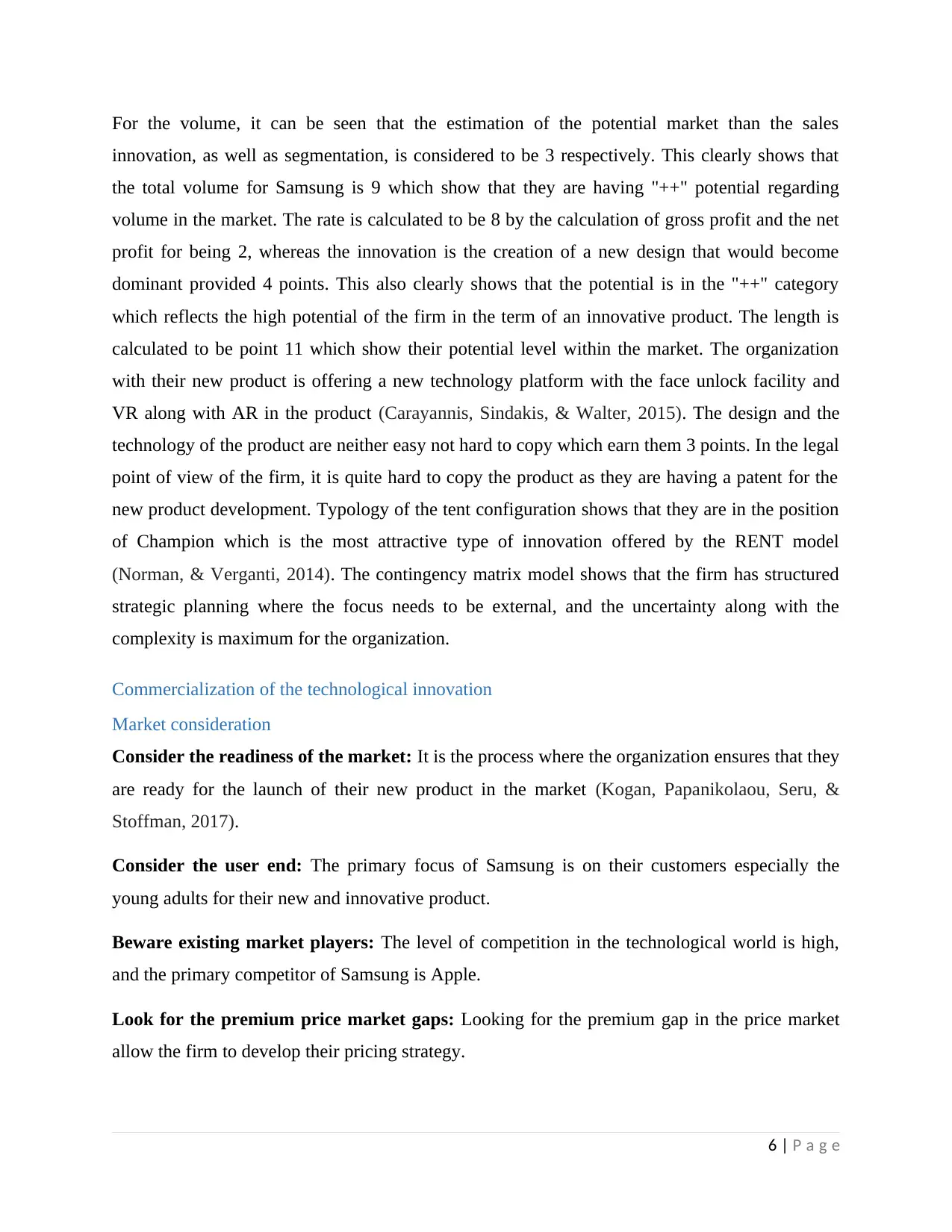
For the volume, it can be seen that the estimation of the potential market than the sales
innovation, as well as segmentation, is considered to be 3 respectively. This clearly shows that
the total volume for Samsung is 9 which show that they are having "++" potential regarding
volume in the market. The rate is calculated to be 8 by the calculation of gross profit and the net
profit for being 2, whereas the innovation is the creation of a new design that would become
dominant provided 4 points. This also clearly shows that the potential is in the "++" category
which reflects the high potential of the firm in the term of an innovative product. The length is
calculated to be point 11 which show their potential level within the market. The organization
with their new product is offering a new technology platform with the face unlock facility and
VR along with AR in the product (Carayannis, Sindakis, & Walter, 2015). The design and the
technology of the product are neither easy not hard to copy which earn them 3 points. In the legal
point of view of the firm, it is quite hard to copy the product as they are having a patent for the
new product development. Typology of the tent configuration shows that they are in the position
of Champion which is the most attractive type of innovation offered by the RENT model
(Norman, & Verganti, 2014). The contingency matrix model shows that the firm has structured
strategic planning where the focus needs to be external, and the uncertainty along with the
complexity is maximum for the organization.
Commercialization of the technological innovation
Market consideration
Consider the readiness of the market: It is the process where the organization ensures that they
are ready for the launch of their new product in the market (Kogan, Papanikolaou, Seru, &
Stoffman, 2017).
Consider the user end: The primary focus of Samsung is on their customers especially the
young adults for their new and innovative product.
Beware existing market players: The level of competition in the technological world is high,
and the primary competitor of Samsung is Apple.
Look for the premium price market gaps: Looking for the premium gap in the price market
allow the firm to develop their pricing strategy.
6 | P a g e
innovation, as well as segmentation, is considered to be 3 respectively. This clearly shows that
the total volume for Samsung is 9 which show that they are having "++" potential regarding
volume in the market. The rate is calculated to be 8 by the calculation of gross profit and the net
profit for being 2, whereas the innovation is the creation of a new design that would become
dominant provided 4 points. This also clearly shows that the potential is in the "++" category
which reflects the high potential of the firm in the term of an innovative product. The length is
calculated to be point 11 which show their potential level within the market. The organization
with their new product is offering a new technology platform with the face unlock facility and
VR along with AR in the product (Carayannis, Sindakis, & Walter, 2015). The design and the
technology of the product are neither easy not hard to copy which earn them 3 points. In the legal
point of view of the firm, it is quite hard to copy the product as they are having a patent for the
new product development. Typology of the tent configuration shows that they are in the position
of Champion which is the most attractive type of innovation offered by the RENT model
(Norman, & Verganti, 2014). The contingency matrix model shows that the firm has structured
strategic planning where the focus needs to be external, and the uncertainty along with the
complexity is maximum for the organization.
Commercialization of the technological innovation
Market consideration
Consider the readiness of the market: It is the process where the organization ensures that they
are ready for the launch of their new product in the market (Kogan, Papanikolaou, Seru, &
Stoffman, 2017).
Consider the user end: The primary focus of Samsung is on their customers especially the
young adults for their new and innovative product.
Beware existing market players: The level of competition in the technological world is high,
and the primary competitor of Samsung is Apple.
Look for the premium price market gaps: Looking for the premium gap in the price market
allow the firm to develop their pricing strategy.
6 | P a g e
Paraphrase This Document
Need a fresh take? Get an instant paraphrase of this document with our AI Paraphraser
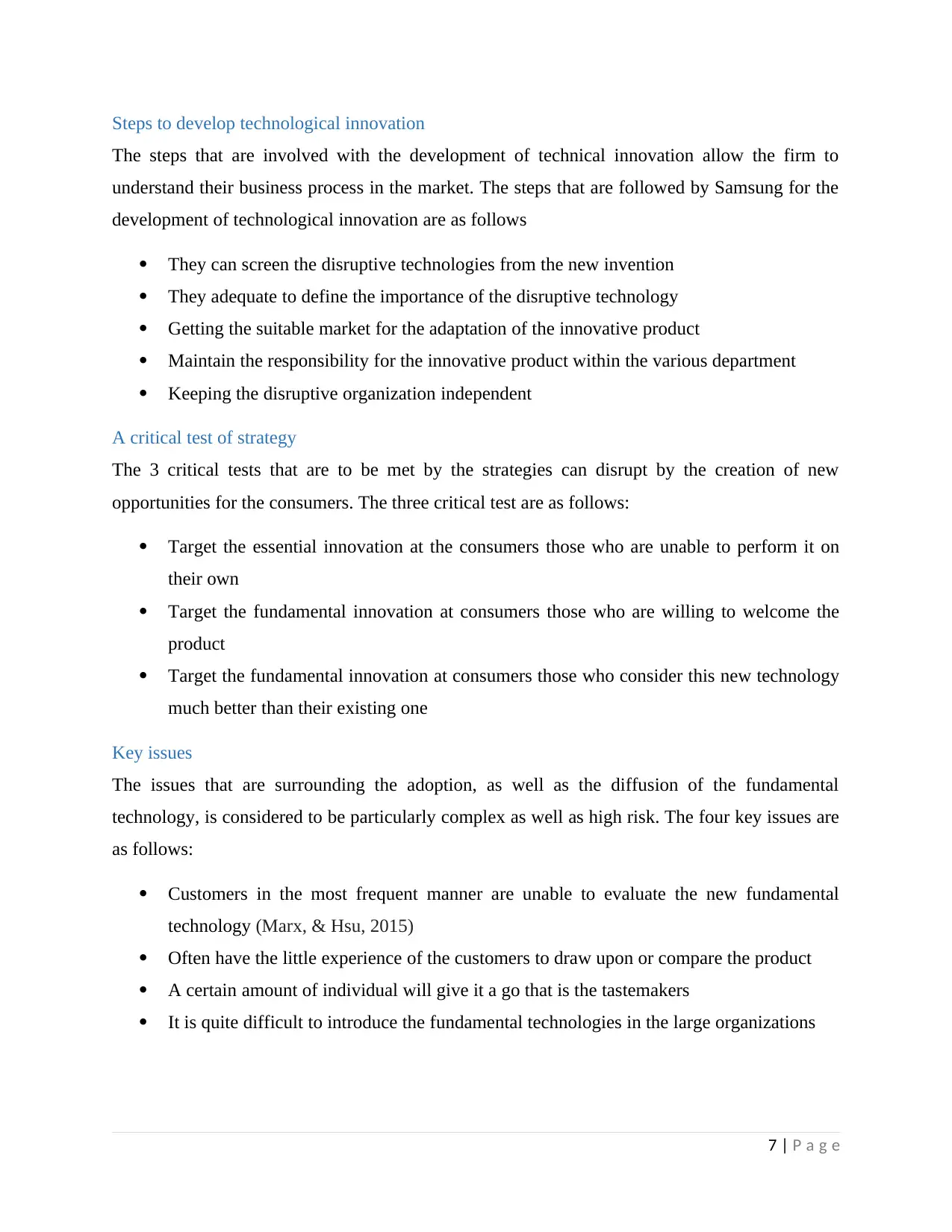
Steps to develop technological innovation
The steps that are involved with the development of technical innovation allow the firm to
understand their business process in the market. The steps that are followed by Samsung for the
development of technological innovation are as follows
They can screen the disruptive technologies from the new invention
They adequate to define the importance of the disruptive technology
Getting the suitable market for the adaptation of the innovative product
Maintain the responsibility for the innovative product within the various department
Keeping the disruptive organization independent
A critical test of strategy
The 3 critical tests that are to be met by the strategies can disrupt by the creation of new
opportunities for the consumers. The three critical test are as follows:
Target the essential innovation at the consumers those who are unable to perform it on
their own
Target the fundamental innovation at consumers those who are willing to welcome the
product
Target the fundamental innovation at consumers those who consider this new technology
much better than their existing one
Key issues
The issues that are surrounding the adoption, as well as the diffusion of the fundamental
technology, is considered to be particularly complex as well as high risk. The four key issues are
as follows:
Customers in the most frequent manner are unable to evaluate the new fundamental
technology (Marx, & Hsu, 2015)
Often have the little experience of the customers to draw upon or compare the product
A certain amount of individual will give it a go that is the tastemakers
It is quite difficult to introduce the fundamental technologies in the large organizations
7 | P a g e
The steps that are involved with the development of technical innovation allow the firm to
understand their business process in the market. The steps that are followed by Samsung for the
development of technological innovation are as follows
They can screen the disruptive technologies from the new invention
They adequate to define the importance of the disruptive technology
Getting the suitable market for the adaptation of the innovative product
Maintain the responsibility for the innovative product within the various department
Keeping the disruptive organization independent
A critical test of strategy
The 3 critical tests that are to be met by the strategies can disrupt by the creation of new
opportunities for the consumers. The three critical test are as follows:
Target the essential innovation at the consumers those who are unable to perform it on
their own
Target the fundamental innovation at consumers those who are willing to welcome the
product
Target the fundamental innovation at consumers those who consider this new technology
much better than their existing one
Key issues
The issues that are surrounding the adoption, as well as the diffusion of the fundamental
technology, is considered to be particularly complex as well as high risk. The four key issues are
as follows:
Customers in the most frequent manner are unable to evaluate the new fundamental
technology (Marx, & Hsu, 2015)
Often have the little experience of the customers to draw upon or compare the product
A certain amount of individual will give it a go that is the tastemakers
It is quite difficult to introduce the fundamental technologies in the large organizations
7 | P a g e
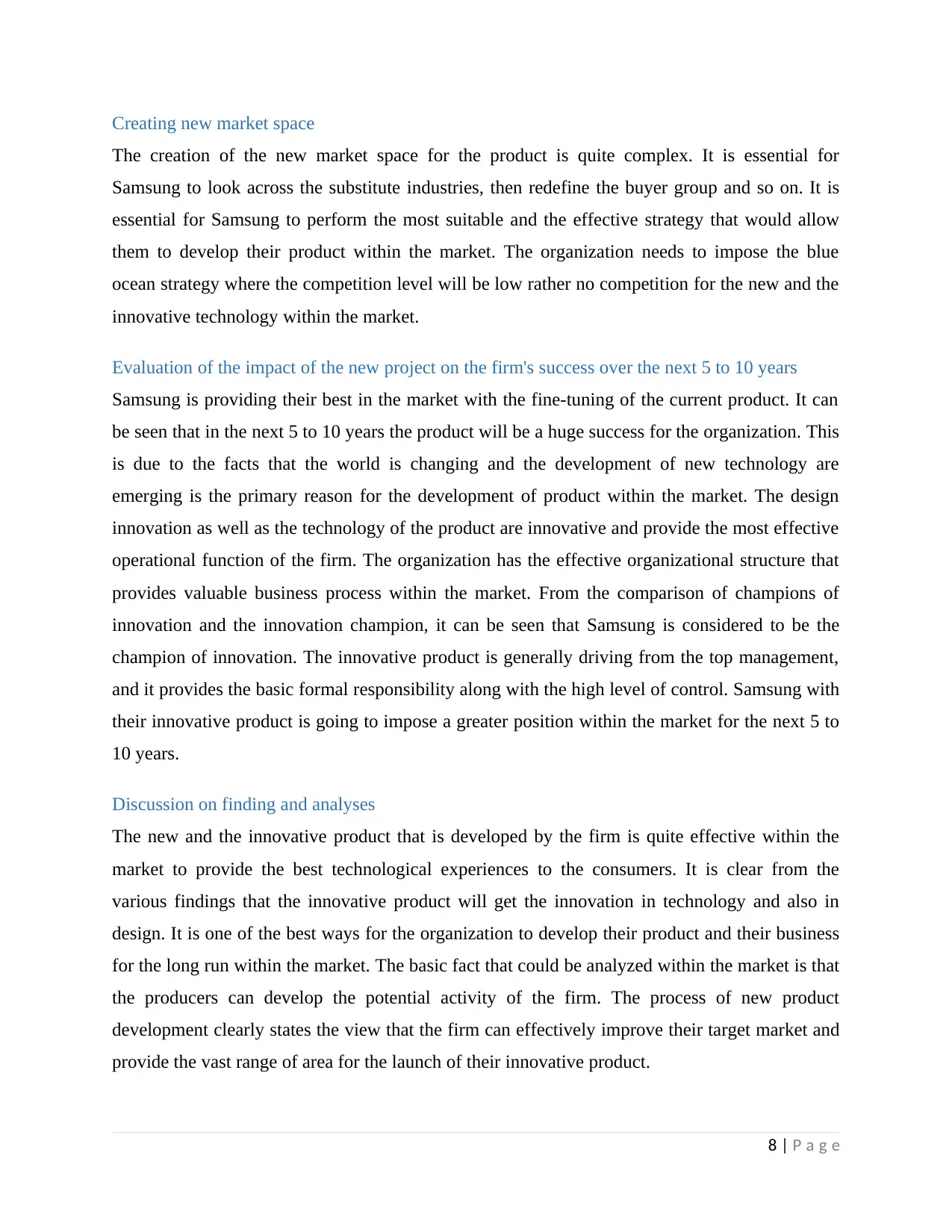
Creating new market space
The creation of the new market space for the product is quite complex. It is essential for
Samsung to look across the substitute industries, then redefine the buyer group and so on. It is
essential for Samsung to perform the most suitable and the effective strategy that would allow
them to develop their product within the market. The organization needs to impose the blue
ocean strategy where the competition level will be low rather no competition for the new and the
innovative technology within the market.
Evaluation of the impact of the new project on the firm's success over the next 5 to 10 years
Samsung is providing their best in the market with the fine-tuning of the current product. It can
be seen that in the next 5 to 10 years the product will be a huge success for the organization. This
is due to the facts that the world is changing and the development of new technology are
emerging is the primary reason for the development of product within the market. The design
innovation as well as the technology of the product are innovative and provide the most effective
operational function of the firm. The organization has the effective organizational structure that
provides valuable business process within the market. From the comparison of champions of
innovation and the innovation champion, it can be seen that Samsung is considered to be the
champion of innovation. The innovative product is generally driving from the top management,
and it provides the basic formal responsibility along with the high level of control. Samsung with
their innovative product is going to impose a greater position within the market for the next 5 to
10 years.
Discussion on finding and analyses
The new and the innovative product that is developed by the firm is quite effective within the
market to provide the best technological experiences to the consumers. It is clear from the
various findings that the innovative product will get the innovation in technology and also in
design. It is one of the best ways for the organization to develop their product and their business
for the long run within the market. The basic fact that could be analyzed within the market is that
the producers can develop the potential activity of the firm. The process of new product
development clearly states the view that the firm can effectively improve their target market and
provide the vast range of area for the launch of their innovative product.
8 | P a g e
The creation of the new market space for the product is quite complex. It is essential for
Samsung to look across the substitute industries, then redefine the buyer group and so on. It is
essential for Samsung to perform the most suitable and the effective strategy that would allow
them to develop their product within the market. The organization needs to impose the blue
ocean strategy where the competition level will be low rather no competition for the new and the
innovative technology within the market.
Evaluation of the impact of the new project on the firm's success over the next 5 to 10 years
Samsung is providing their best in the market with the fine-tuning of the current product. It can
be seen that in the next 5 to 10 years the product will be a huge success for the organization. This
is due to the facts that the world is changing and the development of new technology are
emerging is the primary reason for the development of product within the market. The design
innovation as well as the technology of the product are innovative and provide the most effective
operational function of the firm. The organization has the effective organizational structure that
provides valuable business process within the market. From the comparison of champions of
innovation and the innovation champion, it can be seen that Samsung is considered to be the
champion of innovation. The innovative product is generally driving from the top management,
and it provides the basic formal responsibility along with the high level of control. Samsung with
their innovative product is going to impose a greater position within the market for the next 5 to
10 years.
Discussion on finding and analyses
The new and the innovative product that is developed by the firm is quite effective within the
market to provide the best technological experiences to the consumers. It is clear from the
various findings that the innovative product will get the innovation in technology and also in
design. It is one of the best ways for the organization to develop their product and their business
for the long run within the market. The basic fact that could be analyzed within the market is that
the producers can develop the potential activity of the firm. The process of new product
development clearly states the view that the firm can effectively improve their target market and
provide the vast range of area for the launch of their innovative product.
8 | P a g e
⊘ This is a preview!⊘
Do you want full access?
Subscribe today to unlock all pages.

Trusted by 1+ million students worldwide
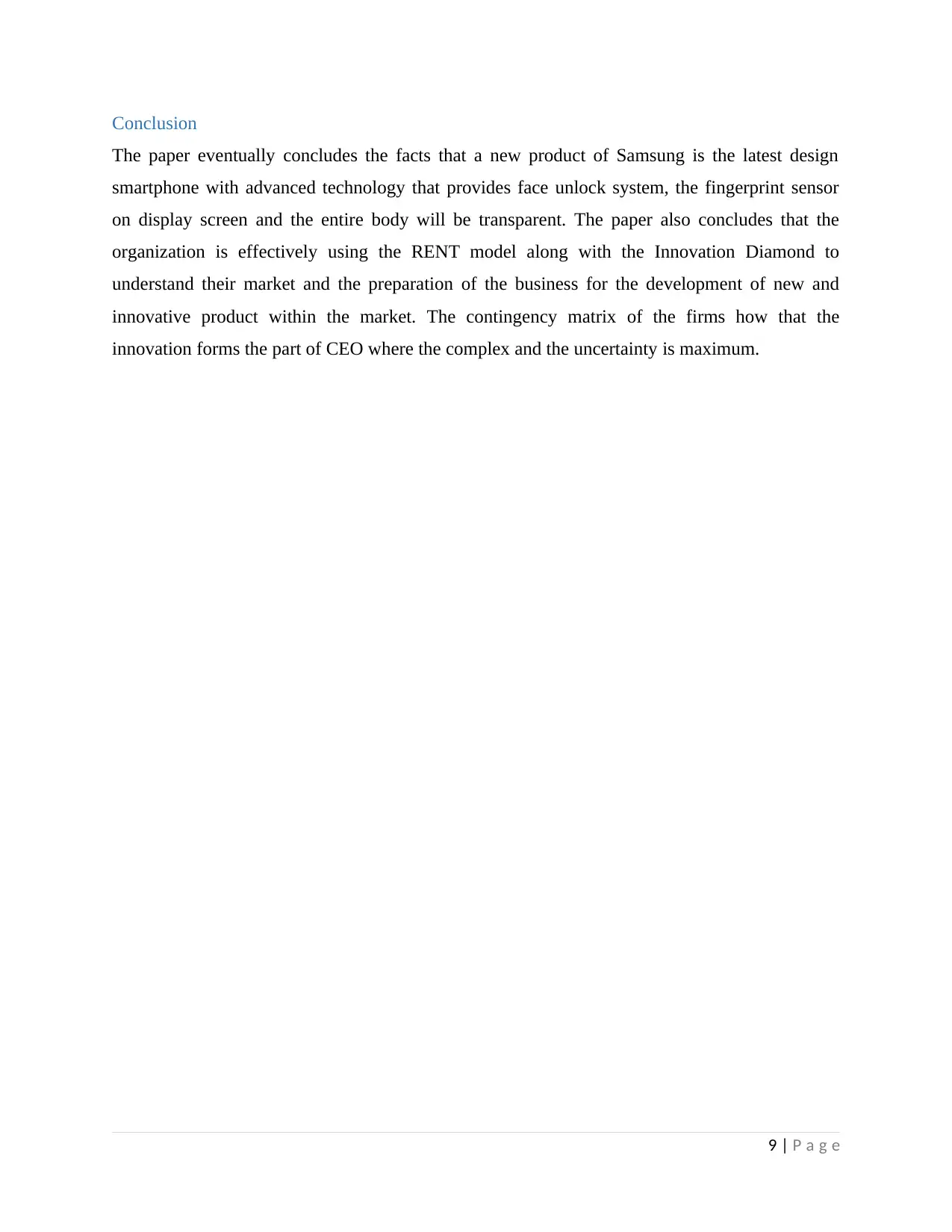
Conclusion
The paper eventually concludes the facts that a new product of Samsung is the latest design
smartphone with advanced technology that provides face unlock system, the fingerprint sensor
on display screen and the entire body will be transparent. The paper also concludes that the
organization is effectively using the RENT model along with the Innovation Diamond to
understand their market and the preparation of the business for the development of new and
innovative product within the market. The contingency matrix of the firms how that the
innovation forms the part of CEO where the complex and the uncertainty is maximum.
9 | P a g e
The paper eventually concludes the facts that a new product of Samsung is the latest design
smartphone with advanced technology that provides face unlock system, the fingerprint sensor
on display screen and the entire body will be transparent. The paper also concludes that the
organization is effectively using the RENT model along with the Innovation Diamond to
understand their market and the preparation of the business for the development of new and
innovative product within the market. The contingency matrix of the firms how that the
innovation forms the part of CEO where the complex and the uncertainty is maximum.
9 | P a g e
Paraphrase This Document
Need a fresh take? Get an instant paraphrase of this document with our AI Paraphraser
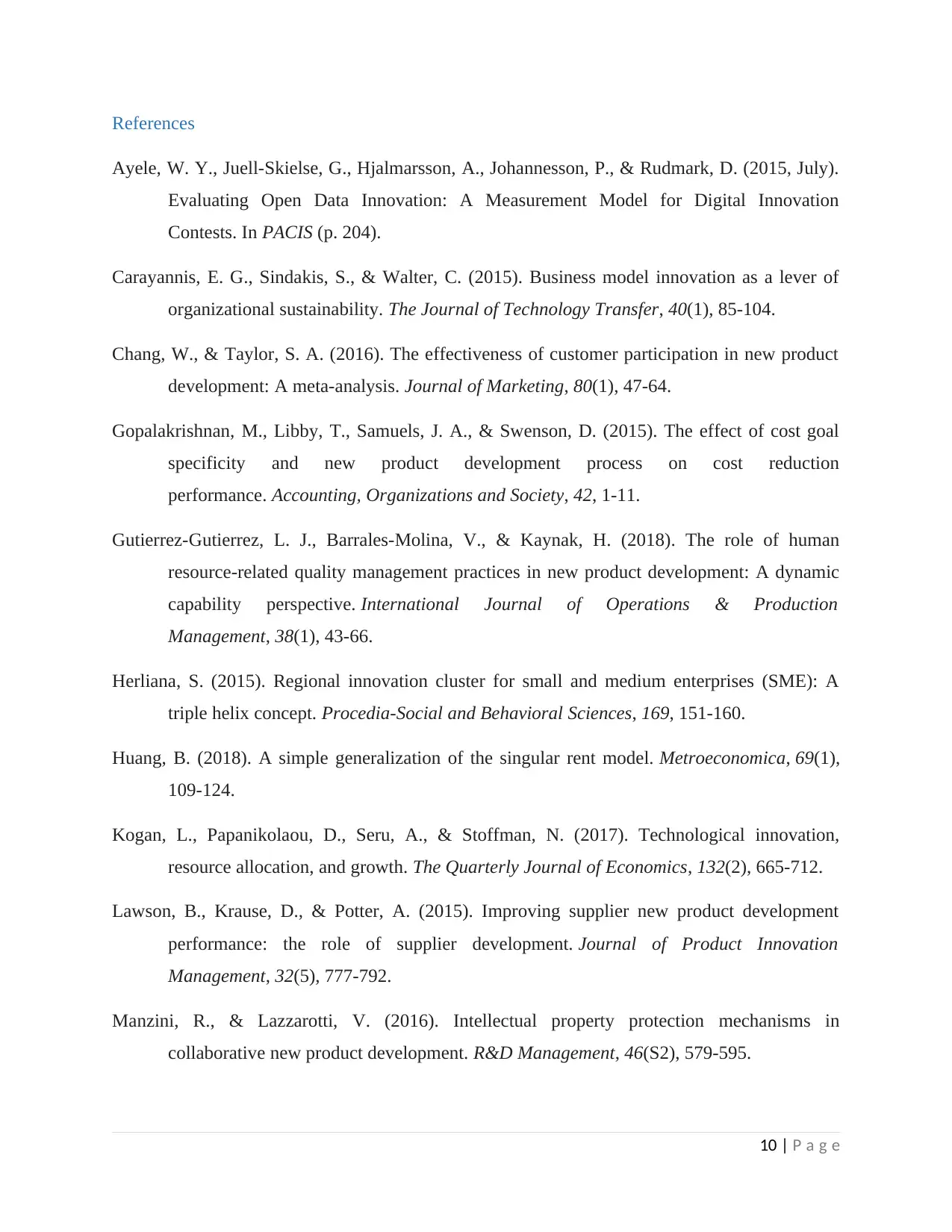
References
Ayele, W. Y., Juell-Skielse, G., Hjalmarsson, A., Johannesson, P., & Rudmark, D. (2015, July).
Evaluating Open Data Innovation: A Measurement Model for Digital Innovation
Contests. In PACIS (p. 204).
Carayannis, E. G., Sindakis, S., & Walter, C. (2015). Business model innovation as a lever of
organizational sustainability. The Journal of Technology Transfer, 40(1), 85-104.
Chang, W., & Taylor, S. A. (2016). The effectiveness of customer participation in new product
development: A meta-analysis. Journal of Marketing, 80(1), 47-64.
Gopalakrishnan, M., Libby, T., Samuels, J. A., & Swenson, D. (2015). The effect of cost goal
specificity and new product development process on cost reduction
performance. Accounting, Organizations and Society, 42, 1-11.
Gutierrez-Gutierrez, L. J., Barrales-Molina, V., & Kaynak, H. (2018). The role of human
resource-related quality management practices in new product development: A dynamic
capability perspective. International Journal of Operations & Production
Management, 38(1), 43-66.
Herliana, S. (2015). Regional innovation cluster for small and medium enterprises (SME): A
triple helix concept. Procedia-Social and Behavioral Sciences, 169, 151-160.
Huang, B. (2018). A simple generalization of the singular rent model. Metroeconomica, 69(1),
109-124.
Kogan, L., Papanikolaou, D., Seru, A., & Stoffman, N. (2017). Technological innovation,
resource allocation, and growth. The Quarterly Journal of Economics, 132(2), 665-712.
Lawson, B., Krause, D., & Potter, A. (2015). Improving supplier new product development
performance: the role of supplier development. Journal of Product Innovation
Management, 32(5), 777-792.
Manzini, R., & Lazzarotti, V. (2016). Intellectual property protection mechanisms in
collaborative new product development. R&D Management, 46(S2), 579-595.
10 | P a g e
Ayele, W. Y., Juell-Skielse, G., Hjalmarsson, A., Johannesson, P., & Rudmark, D. (2015, July).
Evaluating Open Data Innovation: A Measurement Model for Digital Innovation
Contests. In PACIS (p. 204).
Carayannis, E. G., Sindakis, S., & Walter, C. (2015). Business model innovation as a lever of
organizational sustainability. The Journal of Technology Transfer, 40(1), 85-104.
Chang, W., & Taylor, S. A. (2016). The effectiveness of customer participation in new product
development: A meta-analysis. Journal of Marketing, 80(1), 47-64.
Gopalakrishnan, M., Libby, T., Samuels, J. A., & Swenson, D. (2015). The effect of cost goal
specificity and new product development process on cost reduction
performance. Accounting, Organizations and Society, 42, 1-11.
Gutierrez-Gutierrez, L. J., Barrales-Molina, V., & Kaynak, H. (2018). The role of human
resource-related quality management practices in new product development: A dynamic
capability perspective. International Journal of Operations & Production
Management, 38(1), 43-66.
Herliana, S. (2015). Regional innovation cluster for small and medium enterprises (SME): A
triple helix concept. Procedia-Social and Behavioral Sciences, 169, 151-160.
Huang, B. (2018). A simple generalization of the singular rent model. Metroeconomica, 69(1),
109-124.
Kogan, L., Papanikolaou, D., Seru, A., & Stoffman, N. (2017). Technological innovation,
resource allocation, and growth. The Quarterly Journal of Economics, 132(2), 665-712.
Lawson, B., Krause, D., & Potter, A. (2015). Improving supplier new product development
performance: the role of supplier development. Journal of Product Innovation
Management, 32(5), 777-792.
Manzini, R., & Lazzarotti, V. (2016). Intellectual property protection mechanisms in
collaborative new product development. R&D Management, 46(S2), 579-595.
10 | P a g e
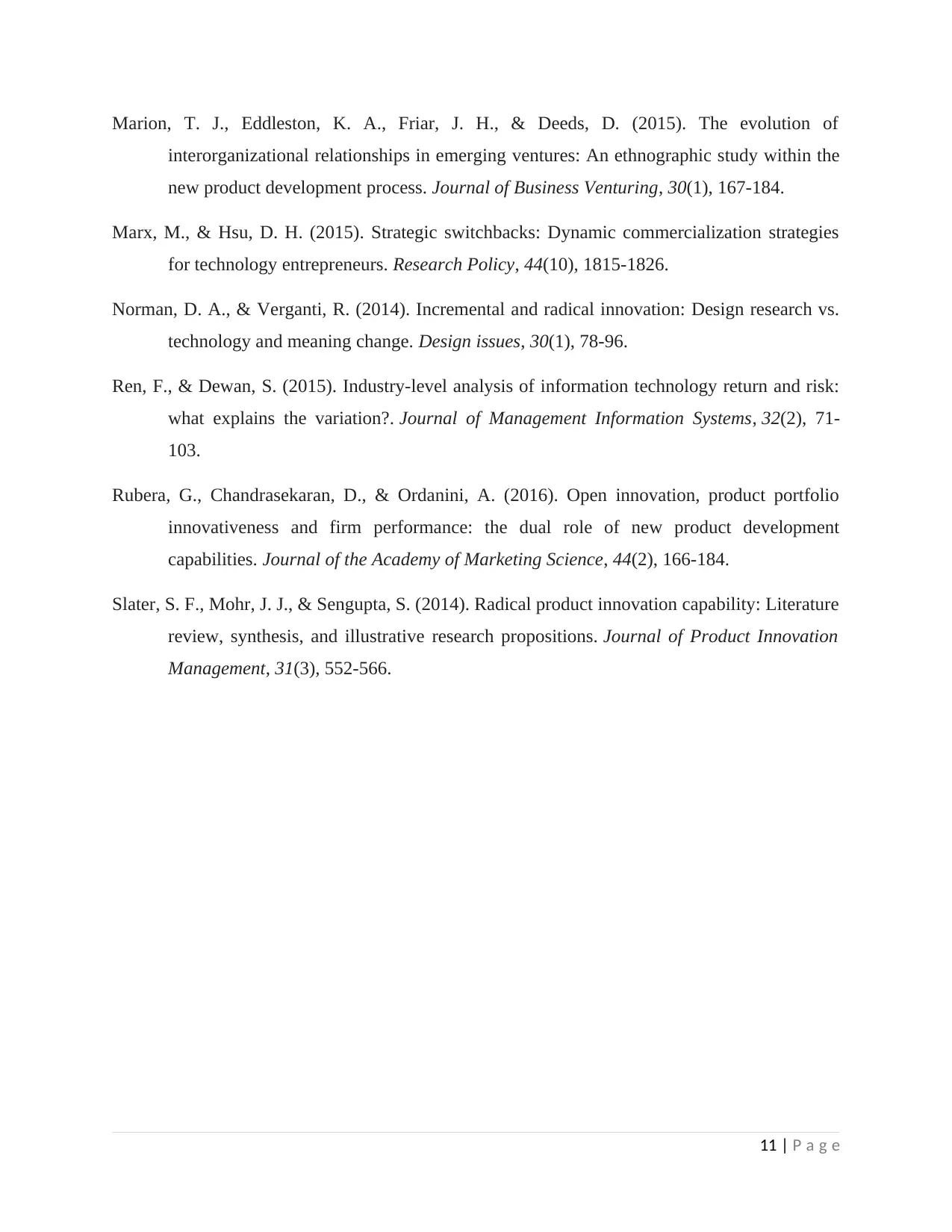
Marion, T. J., Eddleston, K. A., Friar, J. H., & Deeds, D. (2015). The evolution of
interorganizational relationships in emerging ventures: An ethnographic study within the
new product development process. Journal of Business Venturing, 30(1), 167-184.
Marx, M., & Hsu, D. H. (2015). Strategic switchbacks: Dynamic commercialization strategies
for technology entrepreneurs. Research Policy, 44(10), 1815-1826.
Norman, D. A., & Verganti, R. (2014). Incremental and radical innovation: Design research vs.
technology and meaning change. Design issues, 30(1), 78-96.
Ren, F., & Dewan, S. (2015). Industry-level analysis of information technology return and risk:
what explains the variation?. Journal of Management Information Systems, 32(2), 71-
103.
Rubera, G., Chandrasekaran, D., & Ordanini, A. (2016). Open innovation, product portfolio
innovativeness and firm performance: the dual role of new product development
capabilities. Journal of the Academy of Marketing Science, 44(2), 166-184.
Slater, S. F., Mohr, J. J., & Sengupta, S. (2014). Radical product innovation capability: Literature
review, synthesis, and illustrative research propositions. Journal of Product Innovation
Management, 31(3), 552-566.
11 | P a g e
interorganizational relationships in emerging ventures: An ethnographic study within the
new product development process. Journal of Business Venturing, 30(1), 167-184.
Marx, M., & Hsu, D. H. (2015). Strategic switchbacks: Dynamic commercialization strategies
for technology entrepreneurs. Research Policy, 44(10), 1815-1826.
Norman, D. A., & Verganti, R. (2014). Incremental and radical innovation: Design research vs.
technology and meaning change. Design issues, 30(1), 78-96.
Ren, F., & Dewan, S. (2015). Industry-level analysis of information technology return and risk:
what explains the variation?. Journal of Management Information Systems, 32(2), 71-
103.
Rubera, G., Chandrasekaran, D., & Ordanini, A. (2016). Open innovation, product portfolio
innovativeness and firm performance: the dual role of new product development
capabilities. Journal of the Academy of Marketing Science, 44(2), 166-184.
Slater, S. F., Mohr, J. J., & Sengupta, S. (2014). Radical product innovation capability: Literature
review, synthesis, and illustrative research propositions. Journal of Product Innovation
Management, 31(3), 552-566.
11 | P a g e
⊘ This is a preview!⊘
Do you want full access?
Subscribe today to unlock all pages.

Trusted by 1+ million students worldwide
1 out of 15
Related Documents
Your All-in-One AI-Powered Toolkit for Academic Success.
+13062052269
info@desklib.com
Available 24*7 on WhatsApp / Email
![[object Object]](/_next/static/media/star-bottom.7253800d.svg)
Unlock your academic potential
Copyright © 2020–2025 A2Z Services. All Rights Reserved. Developed and managed by ZUCOL.





